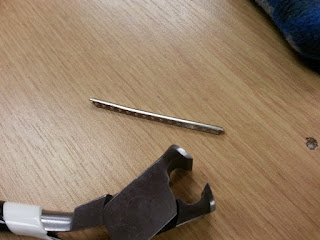At first we thought we could "repurpose" the frets from the original neck from our guitar kit
The specialist fret-pulling tool has a ground surface, allowing the jaws to get right under the fret wire without ripping or causing the (rosewood?) fingerboard to splinter
The frets came out easily enough. But in doing so, the "radius" (slight curve to make them sit nicely along the curved surface of the fingerboard) got straightened out
So even after removing all the frets are carefully keeping them in order, all we managed to do was end up with a load of knackered guitar frets. It makes sense - usually when a proper luthier is removing frets from a guitar, it's because they're worn or need replacing; so if they get damaged, they're only going to end up discarded anyway.
With the frets removed, we had to take the fingerboard off the guitar neck. We'd already tried the household iron trick on this; whether it's the type of glue used in cheap Chinese knock-offs, or magic fret-wire that refuses to transfer heat, we've no idea. But we knew that heat wouldn't be the answer. So we set about hacking it off with a chisel.
The glue held so fast that not even a chisel could prise it off - it simply splintered the wood into little pieces! So we put the neck onto the BuildBrighton bandsaw and sliced it clean off.
After slicing the most part of the fingerboard off the neck, a bit of filing and sanding got the neck surface about as flat and smooth as we could hope
And after mixing some two-part epoxy resin (Araldite) we glued each of the previously placed frets in place. With the glue dry, we cut each fret to length
And using our fancy multi-angled fret file, made sure that there was no nasty overhang where the frets met the edge of the resin fingerboard
We quickly learned the correct way to use the multi-angled file to make the sides of the frets flush with the fingerboard...
...and bevelled the sides of the frets to a nice, consistent, 35 degree angle
(this isn't a photo of us actually doing the filing - it's a photo from Google Images - but it demonstrates the correct way to use the file to bevel the frets)
The fingerboard still needs a little work, but we've managed to get the frets flush to the sides of the resin, and there's very little, or no, snagging as you run your thumb up the side of the fretboard.
With the fingerboard finished, we next need to actually fit it to the neck, build the guitar and give it a whirl!











No comments:
Post a Comment